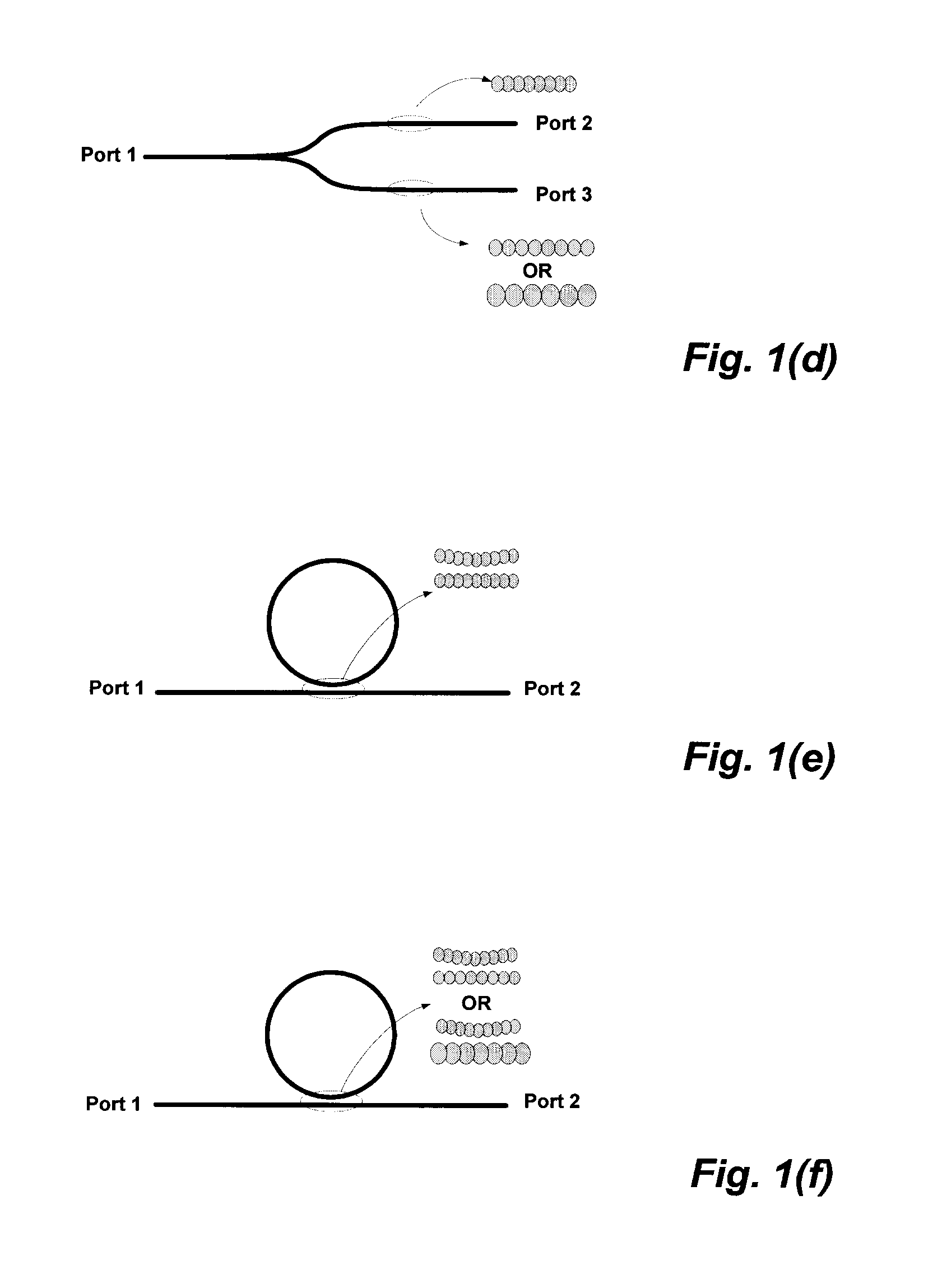Optical devices and digital laser method for writing waveguides, gratings, and integrated optical circuits
a technology of optical devices and lasers, applied in the field of optical devices and digital lasers, can solve the problems of inflexible method in comparison with holographic method, weak reflection of bragg gratings formed in planar lightwave circuits, and relatively slow point-by-point fabrication method, etc., to achieve short period of time, reduce cost, and simplify the effect of fabrication process
- Summary
- Abstract
- Description
- Claims
- Application Information
AI Technical Summary
Benefits of technology
Problems solved by technology
Method used
Image
Examples
example 1
[0071]FIG. 2 depicts a laser writing arrangement in accordance with one example embodiment of the present invention. The laser is delivered to the sample by mirrors and a focusing lens. In this embodiment, the sample is mounted on a two-axis motion stage for horizontal scanning in x or y direction while a vertical motion stage positions the lens to focus the beam at a controlled depth below the surface of the material where modification is confined inside or nearby the laser focal volume.
[0072]In this particular embodiment of the present invention, a pulsed ultrashort (1) is used to deliver 1 kHz pulses with 35 fs minimum duration and 2.5 mJ maximum per pulse energy. The laser beam was relayed to a granite structure (2) in which a 3D air-bearing motion stage system (2) is mounted. The beam coming from the Z direction (optical axis) was then focused by a 0.25NA aspherical lens (4) to ˜200 μm below the surface of a glass sample (Corning EAGLE2000™) (5) of 50×50×1 mm3 size which is fix...
example 2
[0085]GW structures were fabricated by partial or non-overlapping pulses of the same 1 kHz ultrashort laser in fused silica glasses. When focused by a 0.25 NA aspherical lens and scanned with ˜1 mm / s velocity relative to the bulk fused silica glass (50×50×1 mm3), the pulsed laser produced low loss (minimum ˜0.2 dB / cm) waveguides for guiding visible light (633 nm wavelength). The GW structures are similar to the GW structures discussed in example 1 above. However, the laser interaction processes for fused silica are distinguishable in one aspect: the GW structure made in fused silica glass can guide visible wavelength with very low loss compared with the low loss infrared-guiding behaviour in the example above. Further, an examination of a wide 50 fs to 5 ps range of laser pulse duration shows the lowest loss waveguides to form in a narrow 1.0±0.2 ps window. This low-loss processing window has not been previously reported and such relatively long pulse duration significantly exceeds ...
example 3
[0098]Laser exposure conditions were optimized and tighter focusing and longer duration laser pulses led to improved grating strength and reduced waveguide propagation loss. The same 1 kHz Ti:Sapphire ultrafast laser system (Spectra Physics™ Spitfire Pro) delivered 2.4 mJ maximum energy at 800 nm wavelength. The laser pulse duration was tuned from 100 fs to 2 ps by adjusting the laser compressor grating. A tighter 0.55 NA aspheric lens was used to focus the laser beam to ˜1 μm diameter (1 / e2 intensity) at a position 200 μm below the surface of a borosilicate glass sample (Corning EAGLE2000™, 50 mm×10 mm×1 mm). The glass sample was mounted on 3D air-bearing motion stages (Aerotech™ ABL1000, 2 nm resolution and 50 nm repeatability) and scanned transverse to the laser direction to produce 10 mm long grating waveguides. Sample scan speed was fixed at 0.52 mm / s to yield 1st-order Bragg reflection at 1550 nm for the 1 kHz laser repetition rate. The laser energy was adjusted from 0.5 to 10...
PUM
| Property | Measurement | Unit |
|---|---|---|
| pulse energy | aaaaa | aaaaa |
| scanning speed | aaaaa | aaaaa |
| scan velocities | aaaaa | aaaaa |
Abstract
Description
Claims
Application Information
 Login to View More
Login to View More - R&D
- Intellectual Property
- Life Sciences
- Materials
- Tech Scout
- Unparalleled Data Quality
- Higher Quality Content
- 60% Fewer Hallucinations
Browse by: Latest US Patents, China's latest patents, Technical Efficacy Thesaurus, Application Domain, Technology Topic, Popular Technical Reports.
© 2025 PatSnap. All rights reserved.Legal|Privacy policy|Modern Slavery Act Transparency Statement|Sitemap|About US| Contact US: help@patsnap.com



